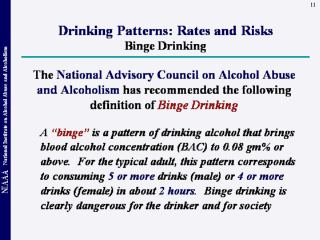Search for most updated materials ↑
| front |1 |2 |3 |4 |5 |6 |7 |8 |9 |10 |11 |12 |13 |14 |15 |16 |17 |18 |19 |20 |21 |22 |23 |24 |25 |26 |27 |28 |29 |30 |31 |32 |33 |34 |35 |36 |37 |38 |39 |40 |41 |42 |review |
 |
Drinking in a manner that will cause
intoxication clearly poses risks to the drinker. A term frequently
used to describe this pattern is binge drinking. Different
definitions have been used for this pattern of drinking. To
provide clarification, the National Advisory Council on Alcohol
Abuse and Alcoholism (NAC) in 2004 developed a standard definition
for binge drinking as a pattern of drinking alcohol that
brings the blood alcohol concentration to 0.08 gram percent (the
legal limit for drinking and driving in all states) or above. The
NAC further noted that for a typical adult male, this BAC level may
be obtained after the consumption of 5 drinks in a 2 hour period,
and for females, 4 drinks in the same time period.
Binge drinking is common across most
life stages. Fifty percent of college students who drink engage in
binge drinking, and twenty percent do so twice or more every three
weeks. More than two-thirds of binge drinking episodes in the U.S.
occur among adults age 26 and older, and half of all binge drinking
episodes occur among people who otherwise drink moderately.
|